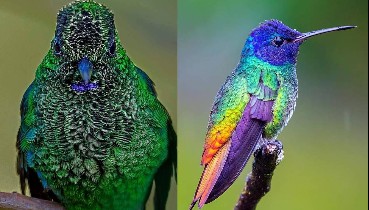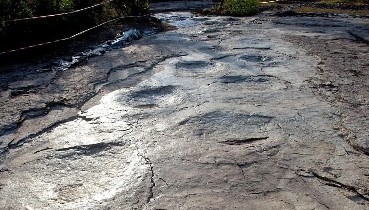
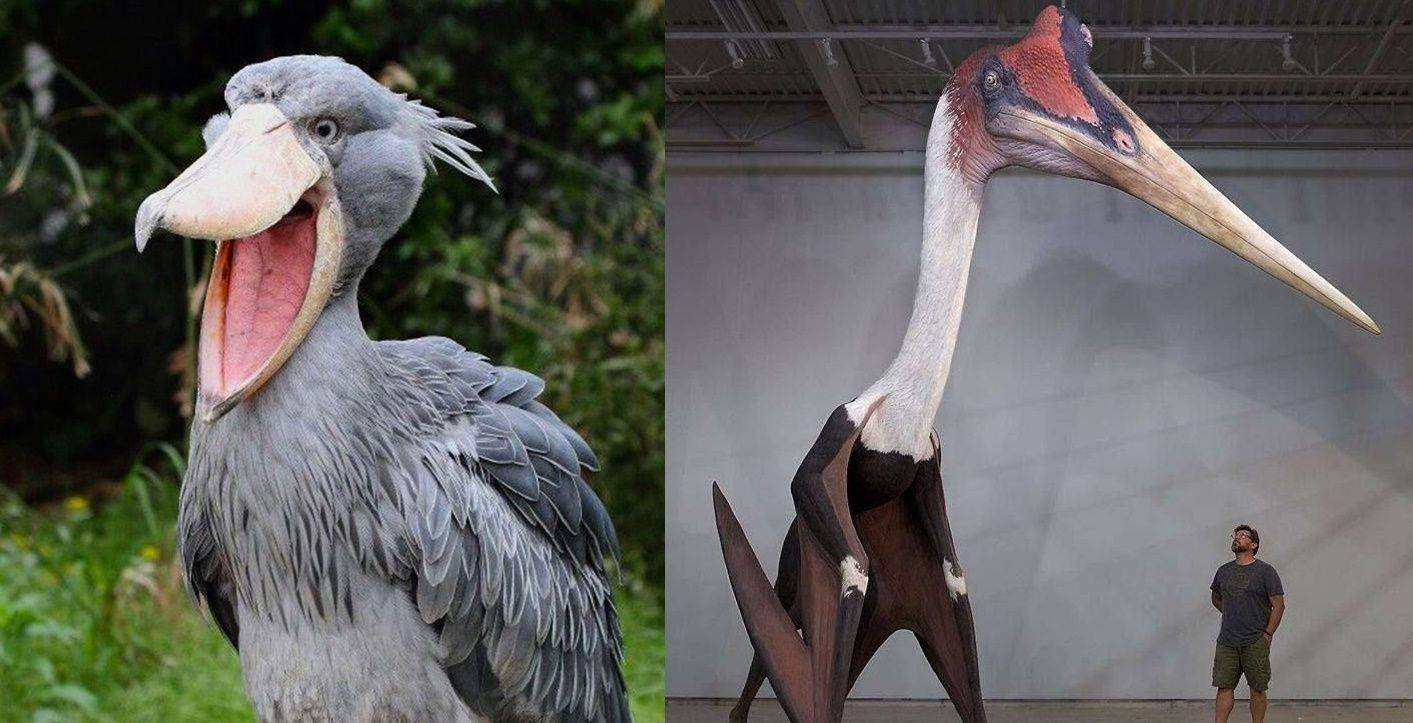
Prehistoric Animals: Paleoartist Shows How These Extinct Animals Might’ve Looked In Real Life In Their 70 Illustrations
Since the early 19th century, artists have depicted colorful – if sometimes fictional – animals (especially dinosaurs) and prehistoric environments, mingling science with unbridled fantasy as more and more fossils got uncovered and studied by the archeologists of that time.
It is pretty clear, though, that by only looking at a cluster of fossils such as bones, not much can be said about the appearance of the said animal that existed a long time ago. For example, the prehistoric reptiles could share similar bone structures thus revealing their true appearance was quite a hard task at the time.
However, nowadays, with the help of computers, artists and archeologists alike can get an idea about what these majestic creatures looked like millions of years ago.
A paleoartist known as “Paleorex” on their Instagram shows how various prehistoric animals might’ve looked like millions of years ago by making 3D renders of them.
More info: Instagram
#1 Velociraptor
Velociraptor is one of the most iconic dinosaurs of all. It was a ferocious hunter that likely relied on its deadly sickle claws to pierce the vital areas of its victim’s body, much like today’s eagles. Velociraptors have been misunderstood ever since they were featured in Jurassic Park as giant scaly dinosaurs. In reality, Velociraptor shared many traits found in modern-day birds, most notably, feathers.
Through art, this long extinct and fascinating animal is bought back to life!
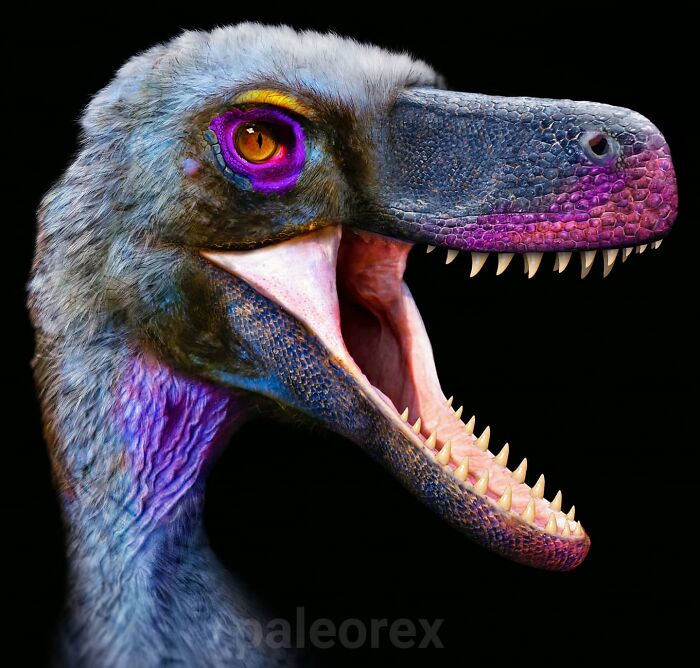 Image credits: paleorex
Image credits: paleorex
The Encylopedia describes paleoart as any original artistic work that attempts to depict prehistoric life according to scientific evidence. Works of paleoart may be representations of fossil remains or imagined depictions of the living creatures and their ecosystems. While paleoart is typically defined as being scientifically informed, it is often the basis of depictions of prehistoric animals in popular culture, which in turn influences public perception of and fuels interest in these animals.
#2 Dorygnathus
Dorygnathus was a small pterosaur that lived in Europe during the Early Jurassic period approximately 180 million years ago when shallow seas flooded much of the continent. This flying reptile had a short wingspan of about 1.5 meters. The most striking feature of Dorygnathus is its incredible teeth, which were very long and sharp, ideal for catching small aquatic prey like prehistoric fish and squids.
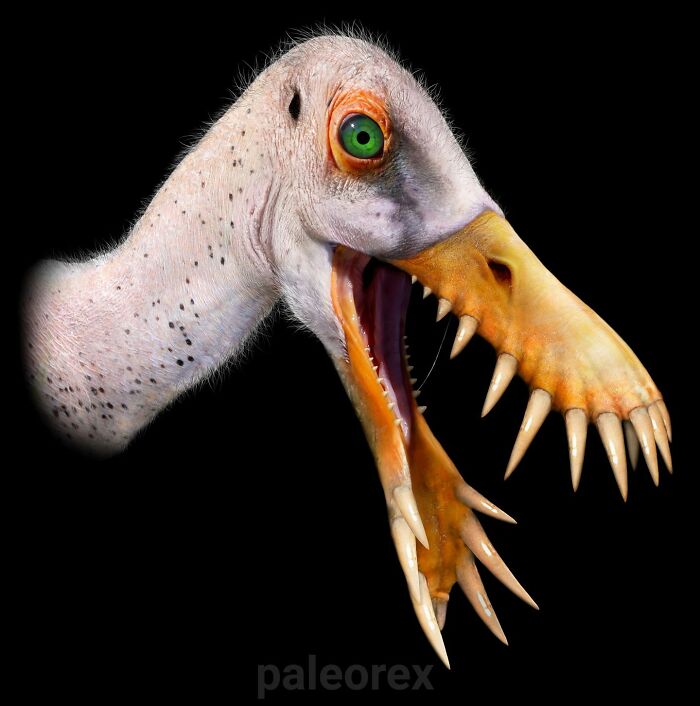 Image credits: paleorex
Image credits: paleorex
#3 Smilodon
Up until about 10,000 years ago, the saber-toothed cat Smilodon was a ferocious predator that dominated the primeval landscape of the Americas. Smilodon means “knife-tooth”, a perfectly fitting name given its enormous fangs, which measured up to 28 centimeters in length. This 250-kilogram feline was an apex predator and primarily hunted the large mammals it shared the land with, such as bison and camels.
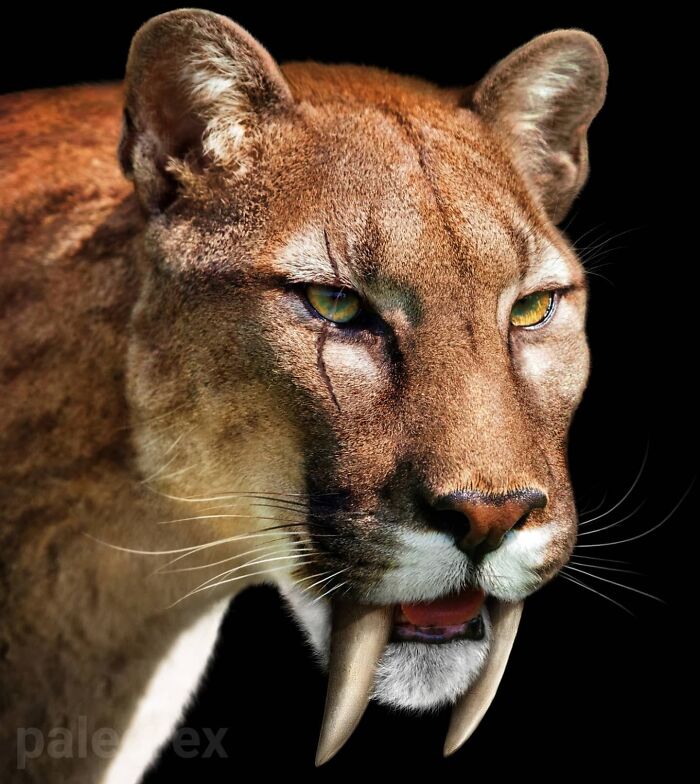 Image credits: paleorex
Image credits: paleorex
In case you didn’t know, through paleoart, most of the fossils found are “revived.” A single drawing or sculpture can define how the public will visualize a whole category of extinct species. So paleoartists strive to keep their work as accurate as possible—a task that gets harder when the experts disagree and when more data is found and proved inaccurate.
#4 Barbourofelis
Barbourofelis was one of the largest “false saber-tooth cats”, which were carnivorous mammals that, due to convergent evolution, evolved to be very similar in appearance to cats, even though they were quite distantly related. Barbourofelis was up to 1.8 meters long and was a powerfully built predator, with a skeletal structure that is indicative of a strongly developed musculature. This hints Barbourofelis was a fierce predator, which likely hunted large prey in North America during the Pliocene.
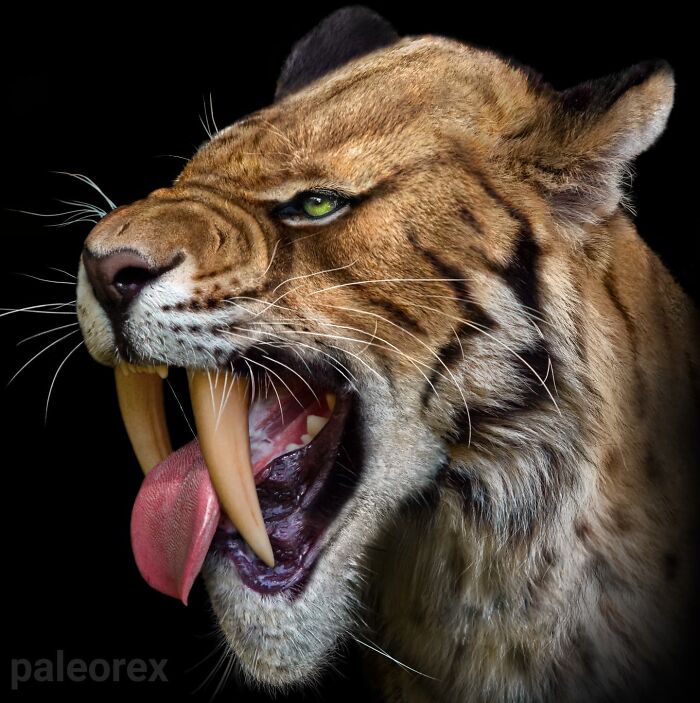 Image credits: paleorex
Image credits: paleorex
#5 Guanlong
In the late Jurassic it would have been hard to believe that such a relatively small predator like Guanlong would lead to the evolution of one of the largest and most ferocious carnivorous dinosaurs of all, Tyrannosaurus rex! In fact, it is one of the first known tyrannosaurids and lived in China about 95 million years before Tyrannosaurus rex. Its name comes from the Chinese words meaning “crown” and “dragon”, a clear reference to its unusual crest, one of the most distinct among known theropod dinosaurs, which was probably used for display and to intimidate rivals.
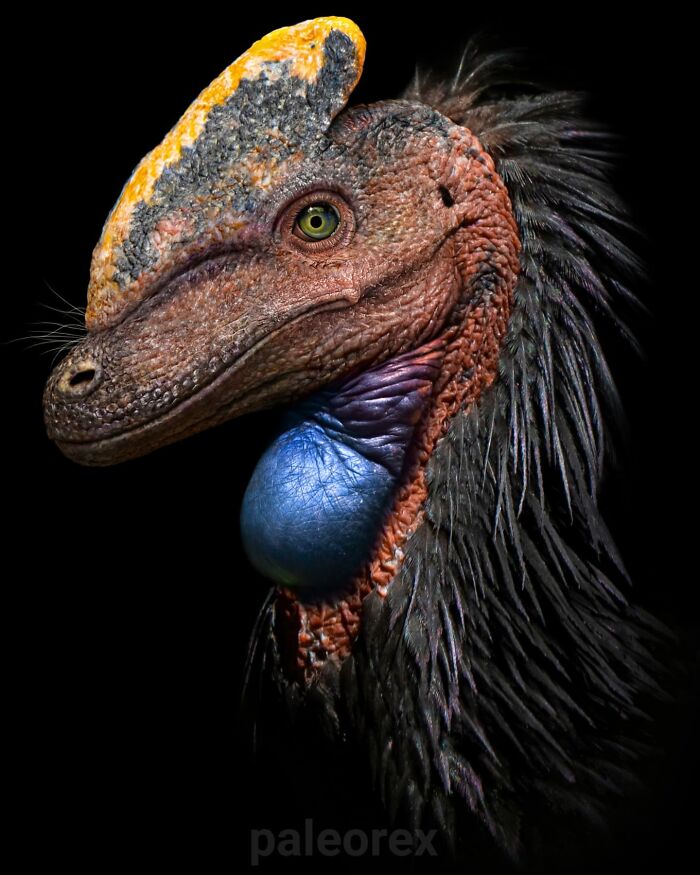 Image credits: paleorex
Image credits: paleorex
Paleoart doesn’t always need to feature dinosaurs, though they are the most prevalent. All prehistoric organisms, from early palm trees to woolly mammoths, make quite worthy subjects! Nevertheless, the charismatic reptiles were pretty much always at the center of attention, and for a significant period in the history of this art form, there was even a “dinosaur renaissance.”
#6 Stegoceras
Stegoceras was the prime example of a pachycephalosaur (“thick-headed lizard”), a family of ornithischian, plant-eating, bipedal dinosaurs, known for their extremely thick skulls. Although Stegoceras had a sleek build, it had a large dome on its head made of thick solid bone. Similarly to modern day bisons, experts believe that Stegoceras males used their very strong heads to shove and head-butt each other to win females during breeding season.
This peculiar dinosaur lived in what is now North America around 75 million years ago, during the Late Cretaceous
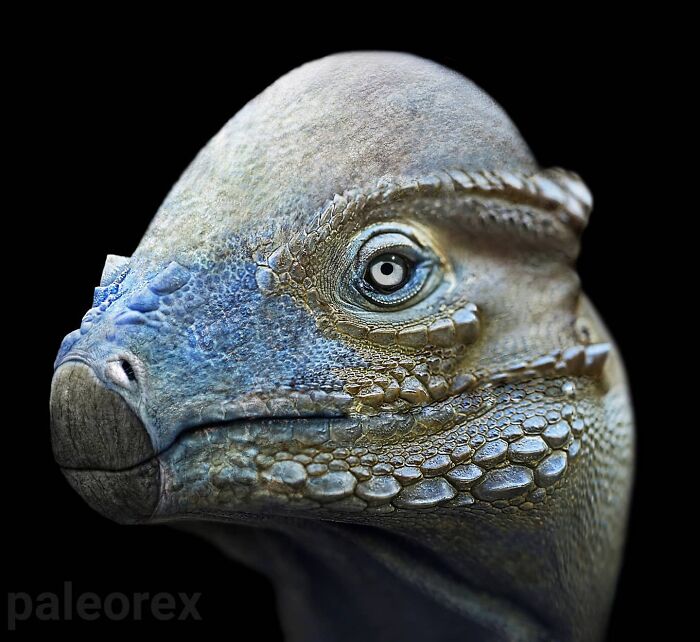 Image credits: paleorex
Image credits: paleorex
#7 Tupandactylus
Some of you know that I really enjoy depicting pterosaurs, especially the more “extreme” ones that used to live during the Cretaceous in what is now Brazil. Recently, a new and perfectly preserved pterosaur specimen of the genus Tupandactylus was discovered and what you see is my depiction of this once fascinating animal. Hope you like it!
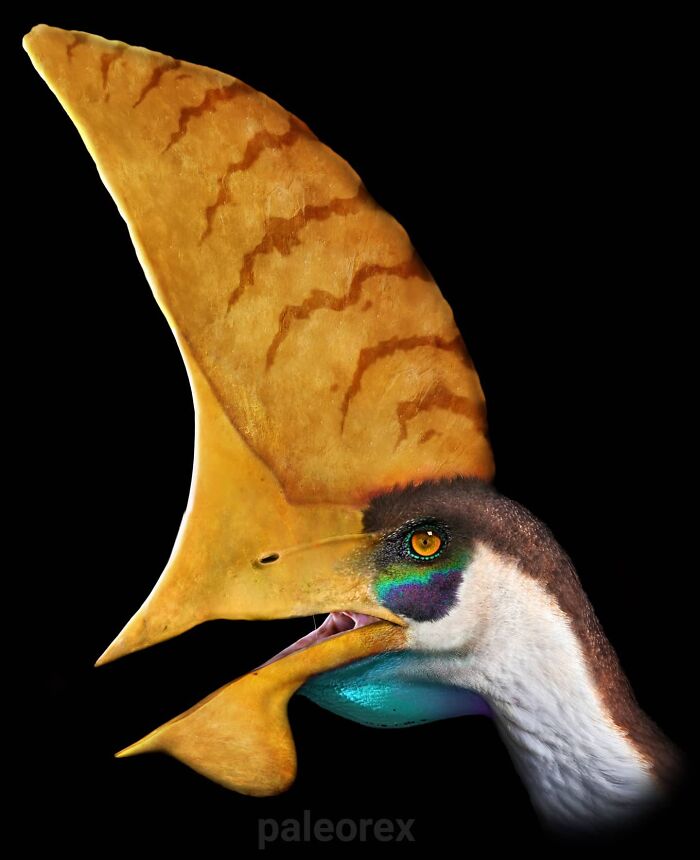 Image credits: paleorex
Image credits: paleorex
It is clear that natural history artwork has always relied heavily on science, but scientific communication also benefits increasingly from carefully executed scientific illustration, in the form of artwork for press releases, manuscript figures, and journal cover images.
#8 Pyroraptor
Pyroraptor was a dromaeosaurid, a small, bird-like predatory theropod that possessed enlarged curved claws on the second toe of each foot. In Pyroraptor, these claws were 6.5 centimeters long and, as in other dromaeosaurids, these claws might have been used as weapons or as climbing aids. Pyroraptor lived during the Late Cretaceous, approximately 70 millions of years ago, in what is now France and Spain.
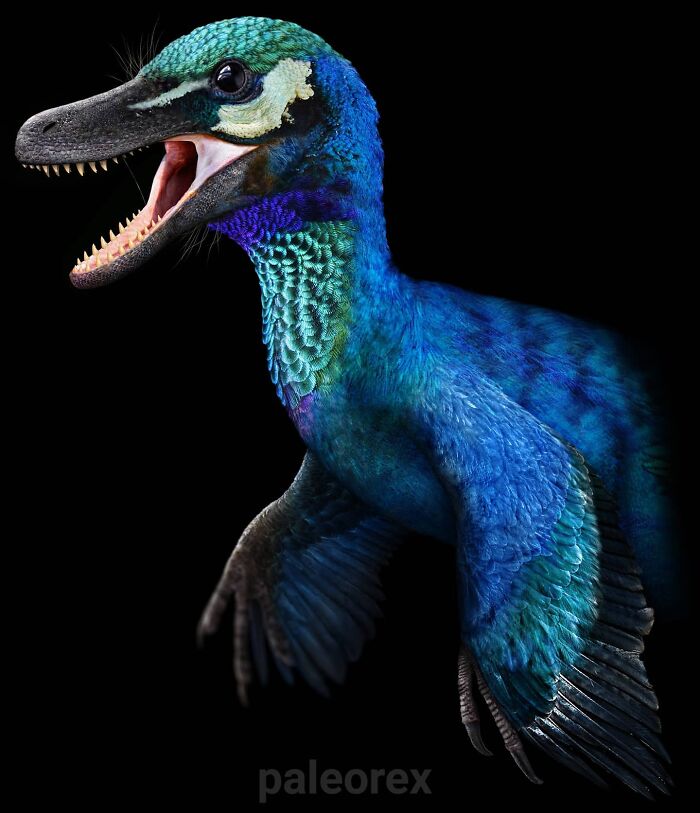 Image credits: paleorex
Image credits: paleorex
#9 Triceratops
Behold the mighty Triceratops, one of the most famous dinosaurs of all!
With its 3 iconic horns, a parrot-like beak, and a large frill, the skull of Triceratops is one of the largest and most striking of any land animal.
It is often considered the toughest of all dinosaurs, and indeed it used its sheer size, body strength, and imposing horns to fend off attacks from one of the deadliest predators to ever live, T-REX.
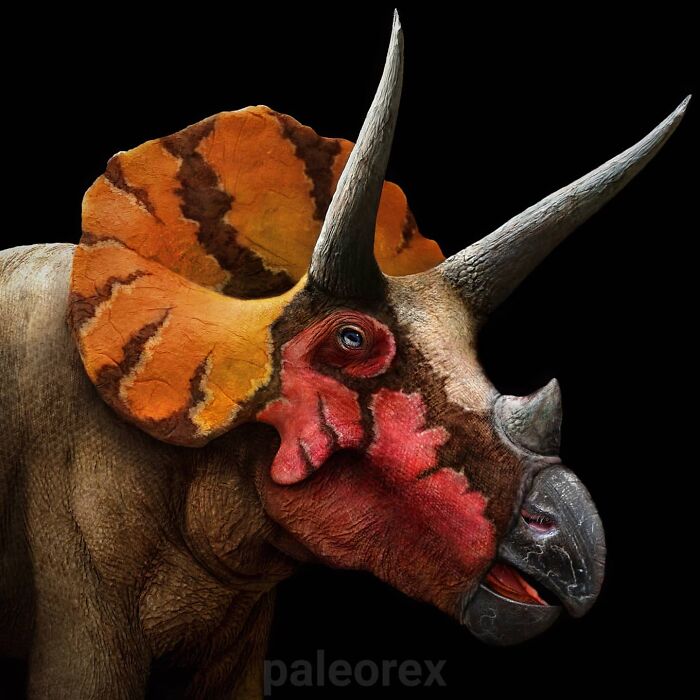 Image credits: paleorex
Image credits: paleorex
#10 Ambulocetus
Ambulocetus was an early amphibious cetacean from Pakistan that lived roughly 48 million years ago during the Early Eocene. The name Ambulocetus means in fact “walking whale,” suggesting that this ancient mammal looked very different from modern whales and more like a dog-like animal. It likely lived both on land and in water, such as lakes and rivers.
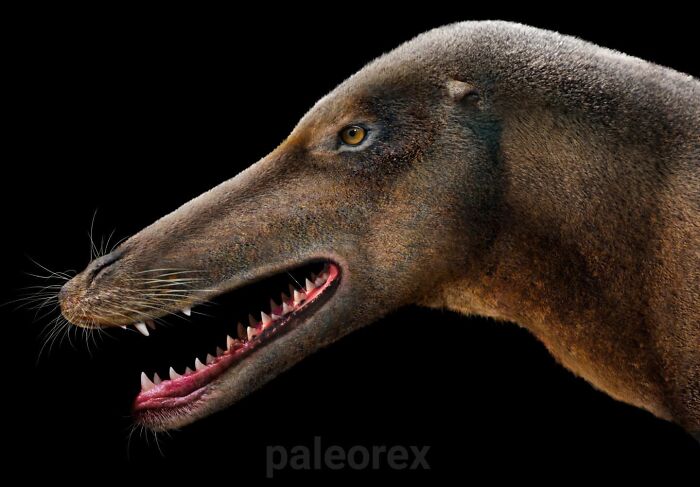 Image credits: paleorex
Image credits: paleorex
#11 Arctodus
Arctodus simus/short-faced bear. The short-faced Ibear was the largest and most powerful land carnivore in North America during the Ice Age. Its most distinctive feature was its very short face, hence its name. It was one of the largest bears to have ever lived, reaching a total body weight of about 700 kg.
Arctodus simus was much taller than modern bears, such as the grizzly bear, but not so heavily built. Additionally, its limbs were longer and more slender compared to modern relatives, suggesting that it was a fast hunter.
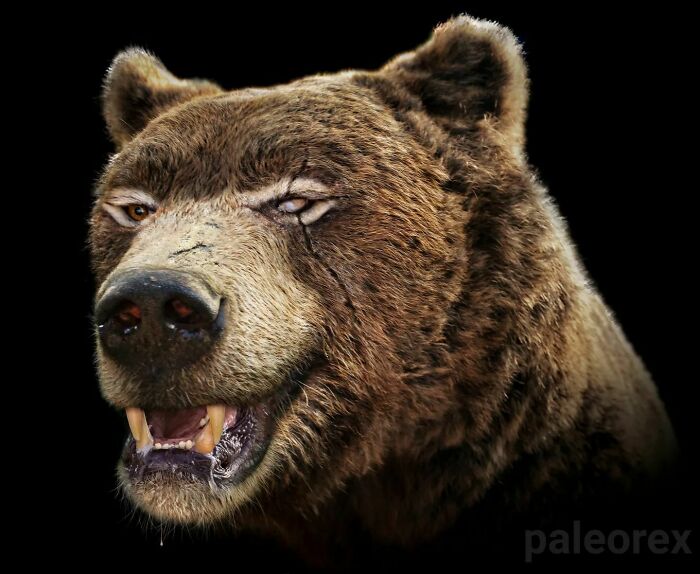 Image credits: paleorex
Image credits: paleorex
#12 Brachiosaurus
The Mesozoic was a time when the ground was literally shaken by the colossal sauropods, the largest land animals to ever exist. Brachiosaurus was among the largest, with a length estimated at 26 meters and a weight of over 50 metric tons. It was so large in size that it was likely immune to all predators. Brachiosaurus had a huge body, a small head and an extremely long neck that allowed it to feed on the leaves of the tall trees that once grew in its habitat of North America. Thanks to their anatomical features, sauropods thrived for almost 100 millions years and were able to inhabit almost every continent.
“With their passing, life will never again be this large”.
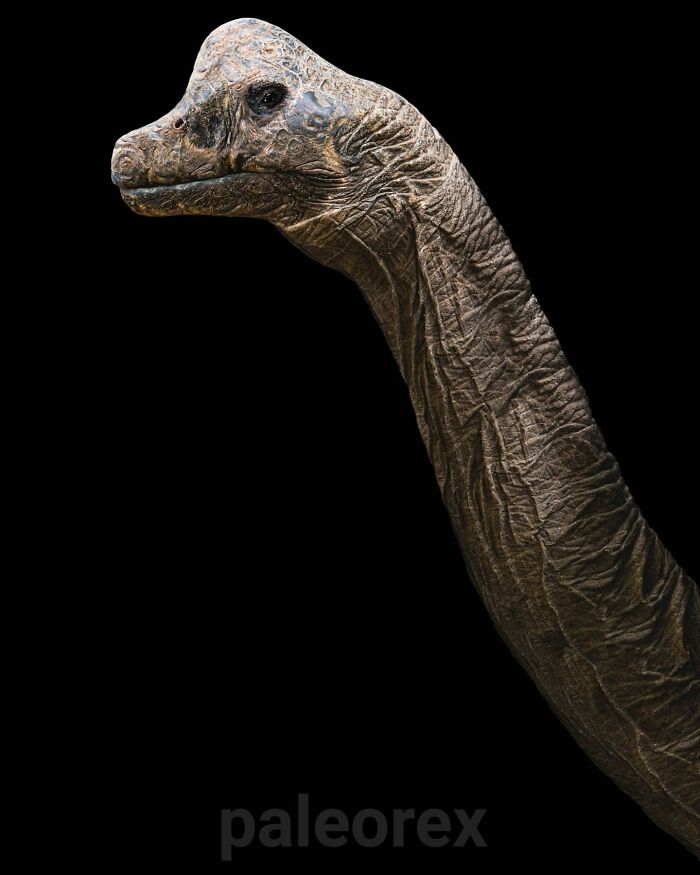 Image credits: paleorex
Image credits: paleorex
#13 Archaeopteryx
Paleontologists view Archaeopteryx as a transitional fossil between dinosaurs and modern birds. With its blend of avian and reptilian features, it was long viewed as the earliest known bird. Discovered in 1860 in Germany, it’s sometimes referred to as the “first bird”. Its name is in fact a combination of two ancient Greek words: archaīos, meaning “ancient,” and préryx, meaning “feather” or “wing.” Archaeopteryx lived about 150 million years ago, during the late Jurassic Period in what is now southern Germany. At the time, most of Europe was an archipelago and was much closer to the equator than it is today, with latitude similar to Florida, providing this basal bird with a fairly warm climate. With an estimated weight of 0.8 kg, Archaeopteryx was about the size of the common raven. It also had well-developed wings and a long feathered tail. Based on these anatomical features, paleontologists believe that Archaeopteryx likely had some aerodynamic abilities, and could, therefore, fly.
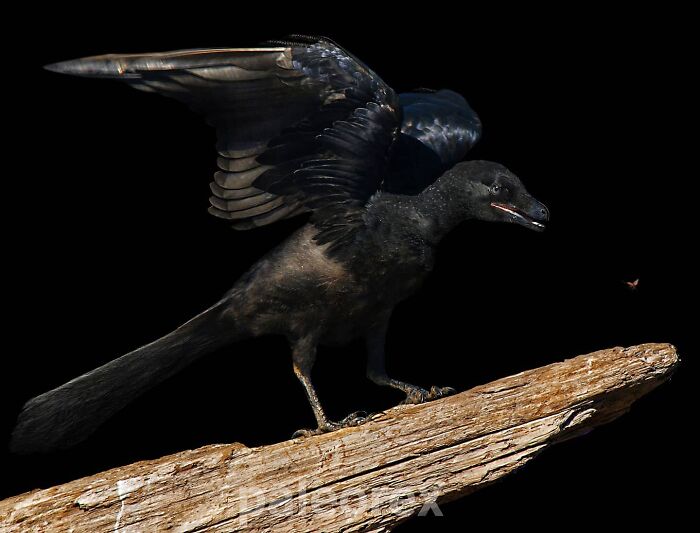 Image credits: paleorex
Image credits: paleorex
#14 Inostrancevia
Inostrancevia lived during the Late Permian period and was the largest of the gorgonopsid species. Inostrancevia’s most striking feature was its long, saber-tooth-like canines. It had a total body length of around 3.5 m, a weight of 300 kg and a huge skull, which measured up to 60 cm in length. Inastroncevia was likely at the top of the food chain in Late Permian Russia, preying on the large herbivorous creatures it shared the land with.
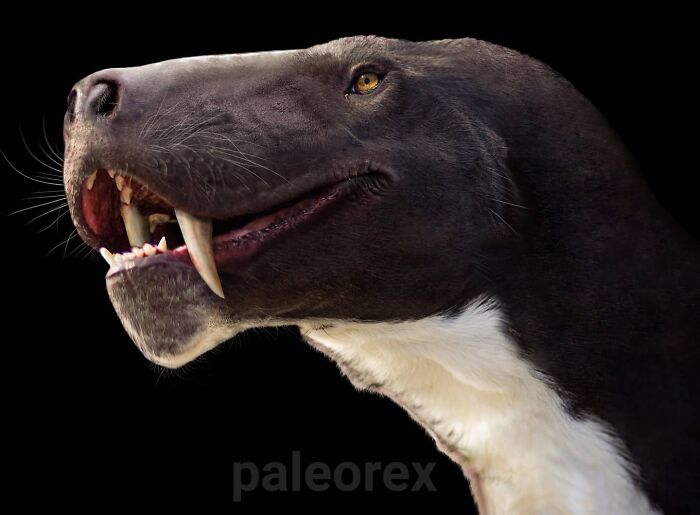 Image credits: paleorex
Image credits: paleorex
#15 Pterodactylus
Pterodactylus is an iconic pterosaur that lived during the Late Jurassic in Germany. It was relatively small for a pterosaur, with a wingspan ranging from 50 centimeters to about 1 meter.
It most likely hunted fish and had many long and narrow conical-shaped teeth.
Like other pterosaurs, Pterodactylus had a crest on its skull composed mainly of soft tissues. However, solid crests have been found on larger, fully grown specimens, indicating that this was a display structure that became larger and more well developed as individuals reached maturity.
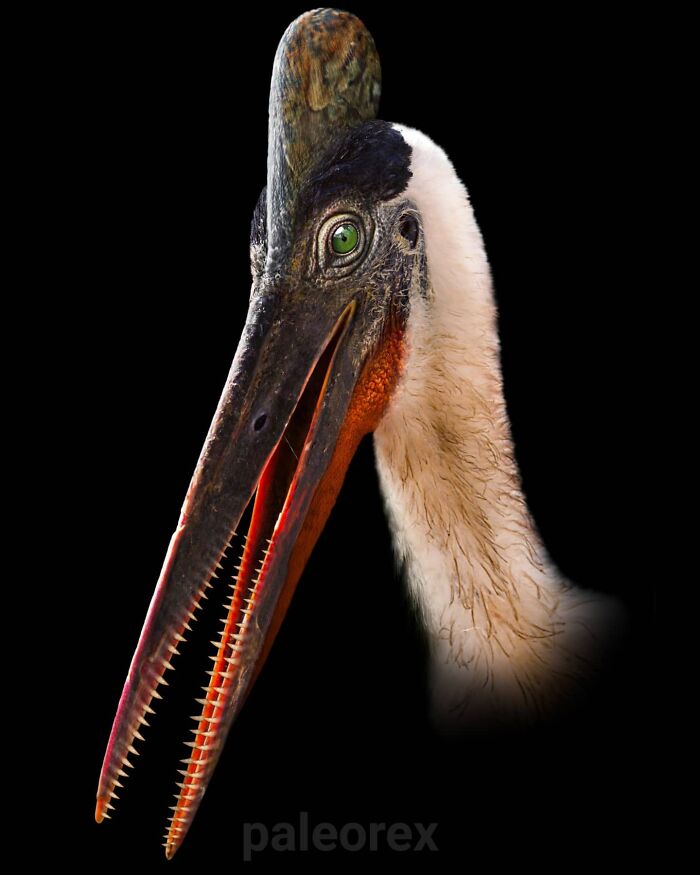 Image credits: paleorex
Image credits: paleorex
#16 Stenonychosaurus
The considerable size of the skull of Stenonychosaurus contains one of the largest brain for its body size of any dinosaur, comparable to that of a modern emu. The teeth were sharp, curved, and serrated. The legs were particularly long and each foot was armed with a large killer claw, like that of the Velociraptor. Its large eyes suggest that Stenonychosaurus had keen eyesight and most likely hunted small prey, such as mammals, birds, and reptiles, at night or at dusk.
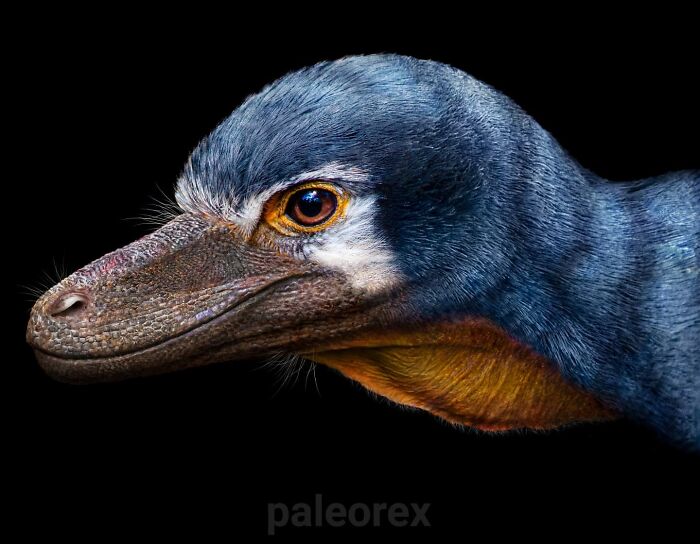 Image credits: paleorex
Image credits: paleorex
#17 Pachycephalosaurus
The unusual and distinctive feature of Pachycephalosaurus is the high, domelike skull formed by a thick mass of solid bone, which safely cushioned its tiny brain. Abundant bony knobs at the front and sides of the skull further added to the unusual appearance. It has been suggested that these animals were head butters like living rams. Pachycephalosaurus lived during the Late Cretaceous Period of what is now North America.
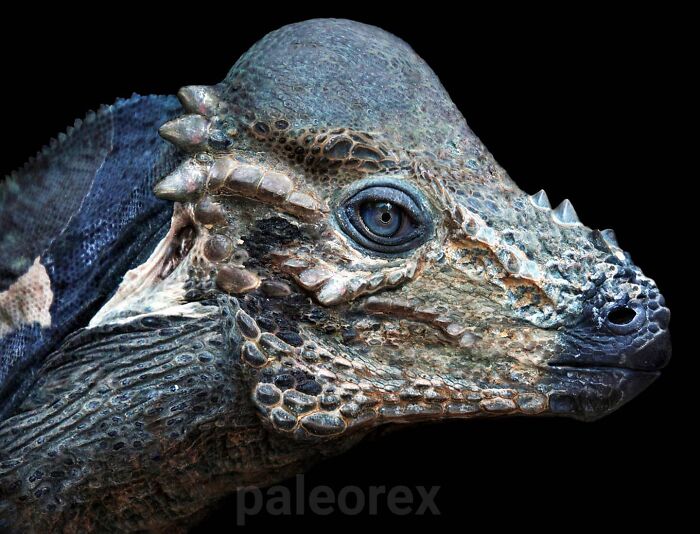 Image credits: paleorex
Image credits: paleorex
#18 Parasaruolophus
Parasaruolophus was a truly bizarre herbivorous dinosaur. Its most striking feature was the long bony crest projecting from the back of the skull. It was hollow and contained a series of tubes that elongated the nasal passages. Perhaps it was used to produce calls in order to keep in touch with its herd in the heart of thick forests. Other theories propose that the crest was used for display or as a means of thermoregulation.
It was a docile herbivore but of considerable size, in fact, its body length is estimated at 9.5 meters, for a weight of over 2 tons.
Parasaruolophus belonged to the hadrosaur family, a group of large herbivorous dinosaurs that is part of to the order of the Ornithischians, which lived during the Cretaceous period.
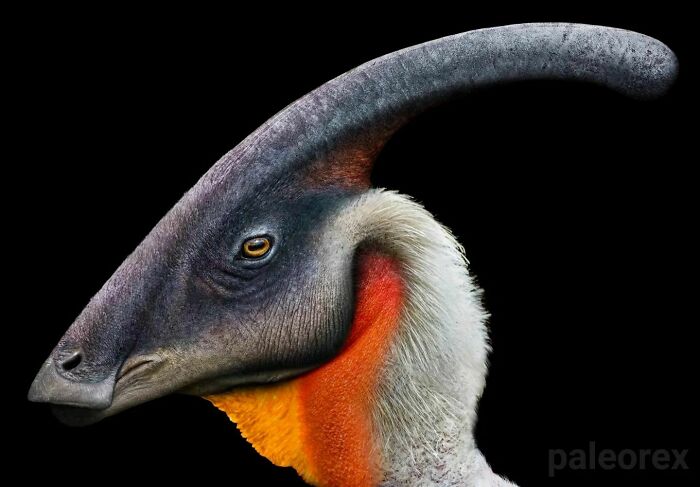 Image credits: paleorex
Image credits: paleorex
#19 Bambiraptor
Bambiraptor is a Late Cretaceous, bird-like dromaeosaurid theropod dinosaur, which lived in North America.
Although only juvenile specimens have been described, it is estimated that a fully grown Bambiraptor would have reached up to 1.5 meters in total length, and perhaps weighed only 5 kilograms. Bambiraptor was likely covered in feathers, and its skeleton shared many similarities with that of a modern bird. Based on analysis of the skull, experts suggest that this species had a brain nearly as large as that of some modern birds. Bambiraptor was also a fast runner and a fierce hunter that may have preyed on small Cretaceous mammals and reptiles.
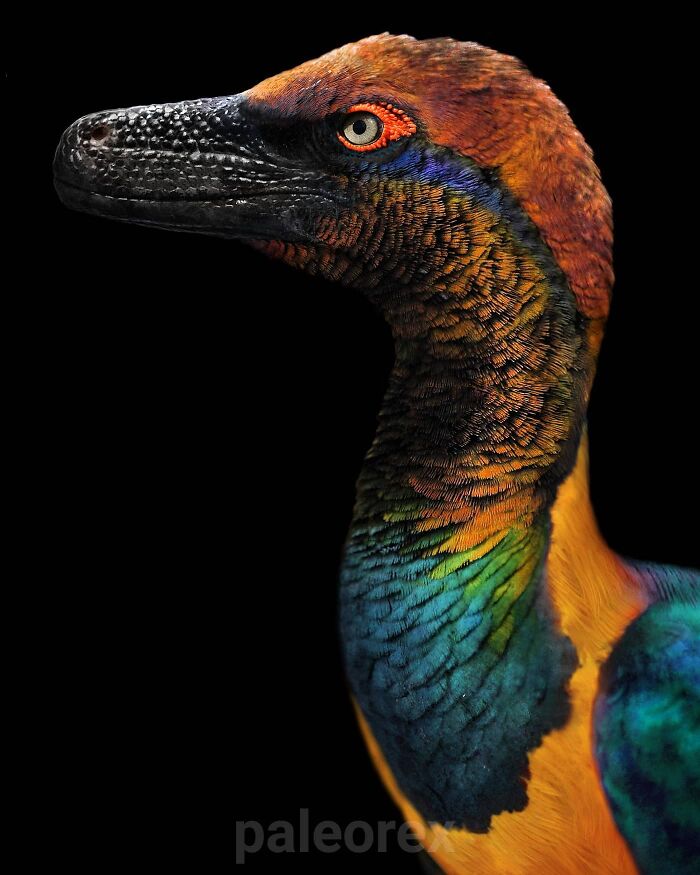 Image credits: paleorex
Image credits: paleorex
#20 Bambiraptor
Bambiraptor is a Late Cretaceous, bird-like dromaeosaurid theropod dinosaur, which lived in North America. Although only juvenile specimens have been described, it is estimated that a fully grown Bambiraptor would have reached up to 1.5 meters in total length, and perhaps weighed only 5 kilograms. Bambiraptor was likely covered in feathers, and its skeleton shared many similarities with that of a modern bird. Based on analysis of the skull, experts suggest that this species had a brain nearly as large and complex as that of some modern birds. Bambiraptor was also a fast runner and a fierce hunter that may have preyed on small Cretaceous mammals and reptiles.
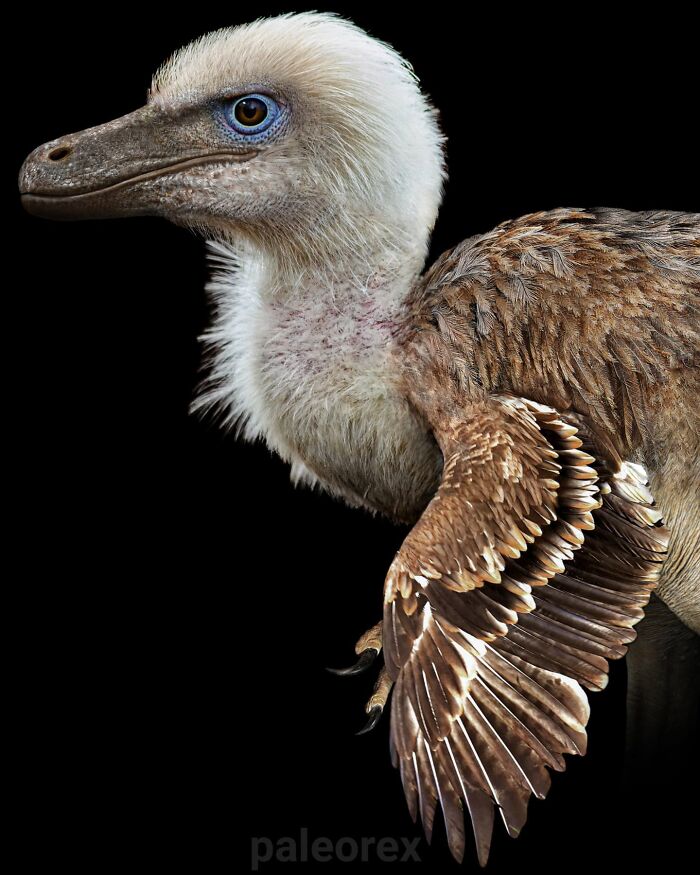 Image credits: paleorex
Image credits: paleorex
#21 Psittacosaurus
Psittacosaurus is a genus of extinct ceratopsian dinosaur from the Early Cretaceous of what is now Asia, existing around 115 million years ago.
The skull of Psittacosaurus is highly modified compared to other ornithischian dinosaurs of its time. It is very tall in height and short in length, and both upper and lower jaws sport a pronounced beak. The bony core of the beak may have been sheathed in keratin to provide a sharp cutting surface for cropping plantmaterial. Additionally, in some species, bony horns protrude from the skull.
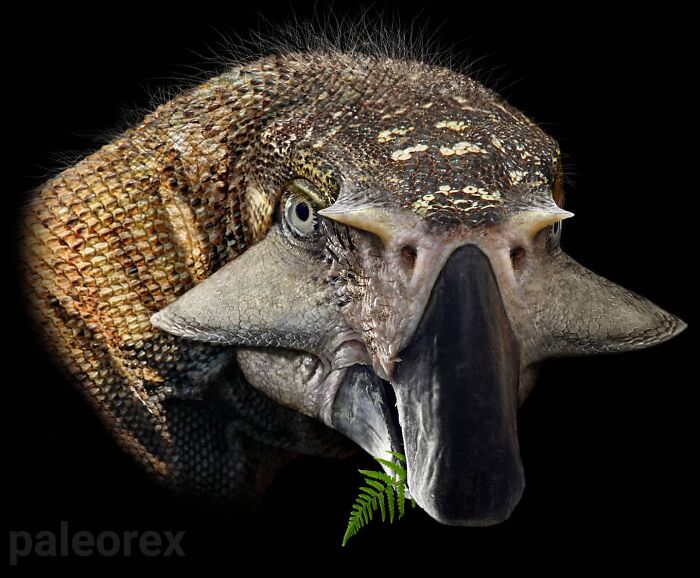 Image credits: paleorex
Image credits: paleorex
#22 Titanis
Titanis was a giant flightless terror bird that inhabited in North America during the early Pliocene to early Pleistocene epochs. Titanis was a large fearsome predator, that was almost 2 meters tall and weighed around 150 kilograms. It had long and powerful legs and it could run at high speeds when hunting its prey. Although its skull has not been discovered yet, it is likely that it had a large, axe-like beak, like its relatives.
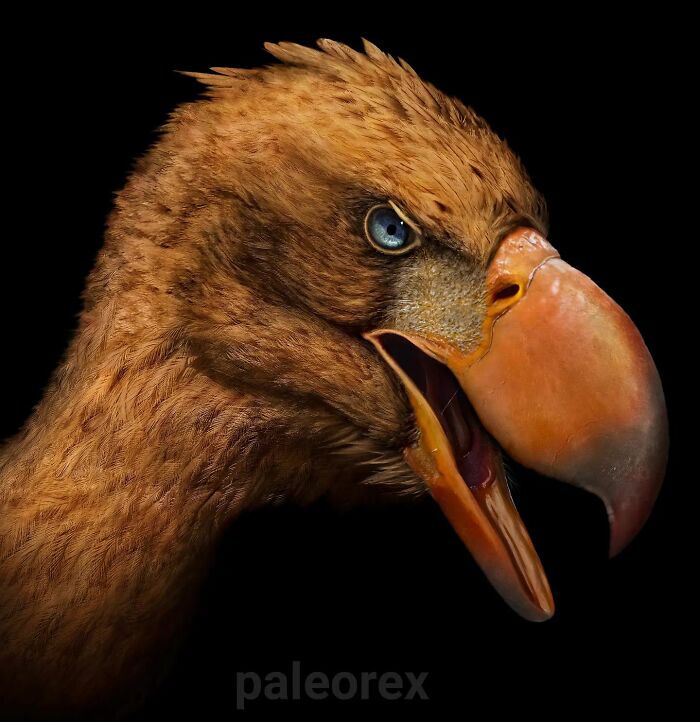 Image credits: paleorex
Image credits: paleorex
#23 Thylacosmilus
Thylacosmilus is an extinct genus of saber-toothed mammals that roamed South America between 9 and 3 million years ago. Though Thylacosmilus looks remarkably similar to the “saber-toothed cats”, it was not a felid, like the well-known North American Smilodon, but a sparassodont, a group related to marsupials, and only superficially resembled other saber-toothed mammals due to convergent evolution.
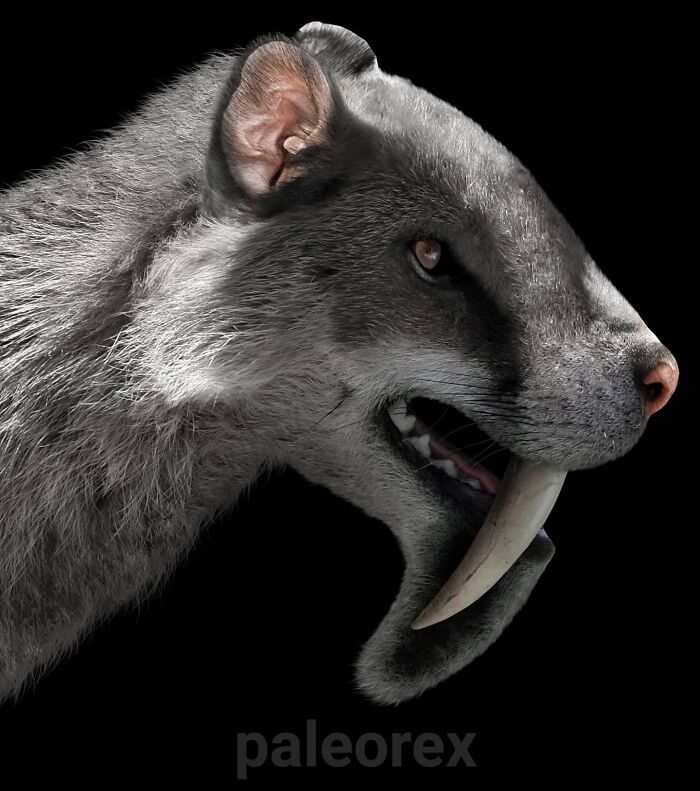 Image credits: paleorex
Image credits: paleorex
#24 Microraptor
Microraptor was a feathered dinosaur, an early ancestor to the birds. Incredibly well-preserved fossil remains found in China, have allowed paleontologists to piece together a better picture of the evolution of dinosaurs, from feathered ground dwelling creatures, to those that took to the skies, leading to the evolution of birds.
At less than one meter in average length, Microraptor was one of the smallest dromaeosaurs or raptors of its time, hence its name, but still remains a specimen of much importance.
Microraptor was unable to efficiently fly through the forests where it once lived during the early Cretaceous, instead it used not two, but four, feathered limbs to glide from tree to tree, likely to hunt its prey or evade from predators. These feathers were also used for maintaining body temperature and for show but, most importantly, their shape created the ideal aerodynamic surface.
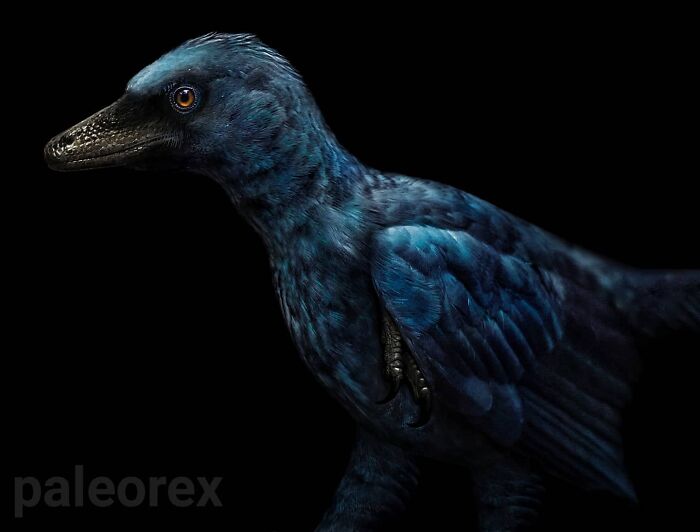 Image credits: paleorex
Image credits: paleorex
#25 Spinosaurus Hunting
Spinosaurus is probably the most enigmatic dinosaur of all. For decades, this colossal theropod has been the subject of much controversy in the scientific community and many have wondered how this predatory giant from the Cretaceous period could live and hunt. Spinosaurus was huge, in fact it is considered the longest known carnivorous dinosaur and measured about 15 meters in length. It also had an extravagant “sail” on its back, which measured more than a man’s height. The function of this peculiar back structure is not known with certainty. One hypothesis suggests that the sail was used to regulate body temperature.
When the animal had its sail turned sideways towards the sun’s rays, its large surface, covered with blood vessels, would quickly absorb the heat, thus heating the whole body. An alternative hypothesis suggests that the sail was decorated with bright colors, and was therefore used by males for sexual displays to attract the attention of females. Recent studies suggest that Spinosaurus spent most of its time in the water and swam using its powerful, fin-like tail. This lifestyle is apparently unique among dinosaurs. There were already several clues that suggested an adaptation of this animal to an aquatic lifestyle: the teeth were similar to those of crocodiles and perfect for catching fish, the front legs were equipped with strong curved claws to hold the most slippery prey, the hind legs were short and the foot bones were broad, suggesting that this dinosaur possessed webbed feet, like those of seabirds.
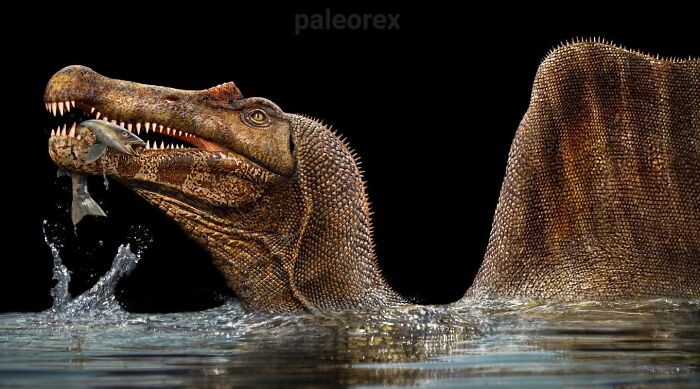 Image credits: paleorex
Image credits: paleorex
#26 Allosaurus
As one of the most abundant large predators in the Jurassic, Allosaurus was at the top of the food chain, likely preying on the large herbivorous dinosaurs and, perhaps, also other predators it shared the land with. It averaged 9.5 meters in length, though fragmentary remains suggest it could have reached over 12 meters, making it one of the largest predatory dinosaurs of its time. The skull had a pair of horns above and in front of the eyes. They were likely covered in a keratin sheath and may have had a variety of functions, including: acting as sunshades for the eyes and being used for display, as they probably possessed a distinct and bright coloration.
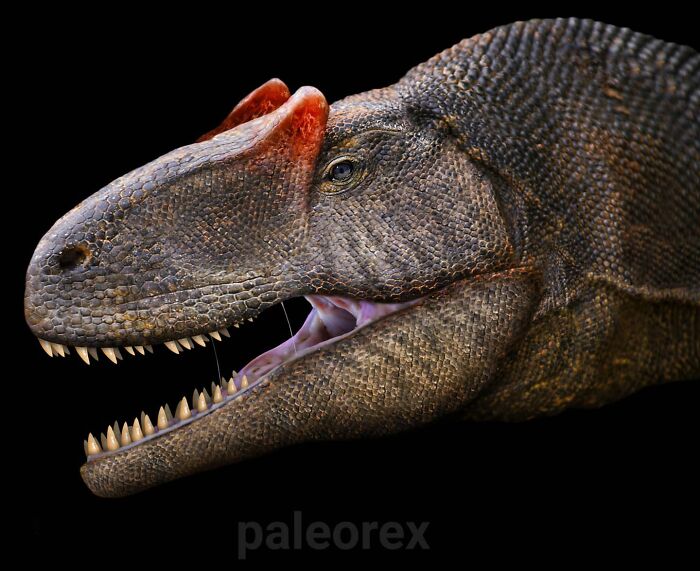 Image credits: paleorex
Image credits: paleorex
#27 Chilotherium
Chilotherium is a genus of prehistoric rhinoceros that lived during the Miocene and Pliocene in Asia and Eastern Europe. At the shoulders, it was as tall as a fully grown man and weighed between 1 to 2.5 tons.
Its most notable feature is its two large upward-curving tusks, formed from enlarged incisor teeth, which rose up from the lower jaw. Although these peculiar tusks were present in both males and females, they seem to have been larger in the males, suggesting that they might have been used for display. They were also likely used for species recognition as well as possible practical applications.
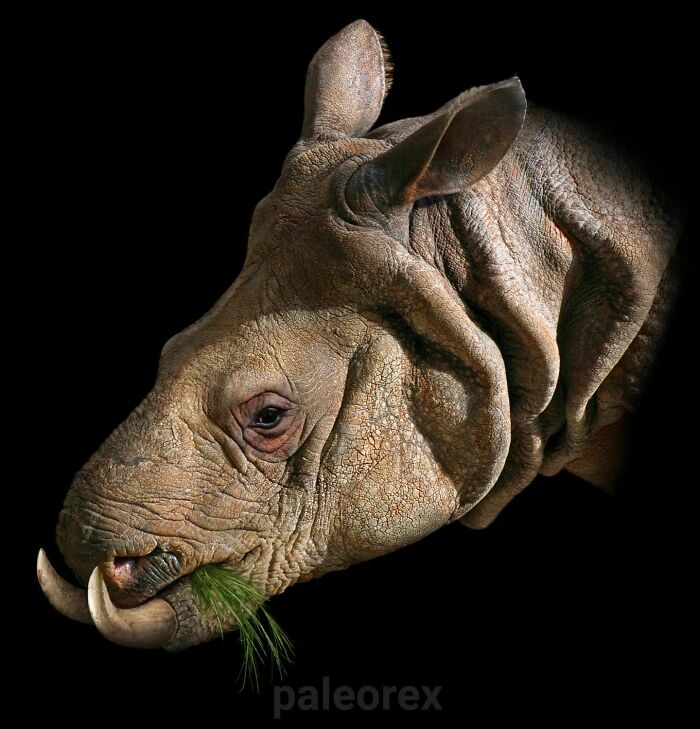 Image credits: paleorex
Image credits: paleorex
#28 Scutellosaurus
Scutellosaurus was a small ornithischian dinosaur that lived approximately 196 million years ago during the Early Jurassic in what is now Arizona, USA. Scutellosaurus was lightly built and was around 1.2 metres long and 50 centimeters tall. One of the more striking features of this small herbivorous dinosaur was the large number of osteoderms that ran along its neck to its back and as far down as its tail. These formed parallel rows, with as many as five rows on each side.
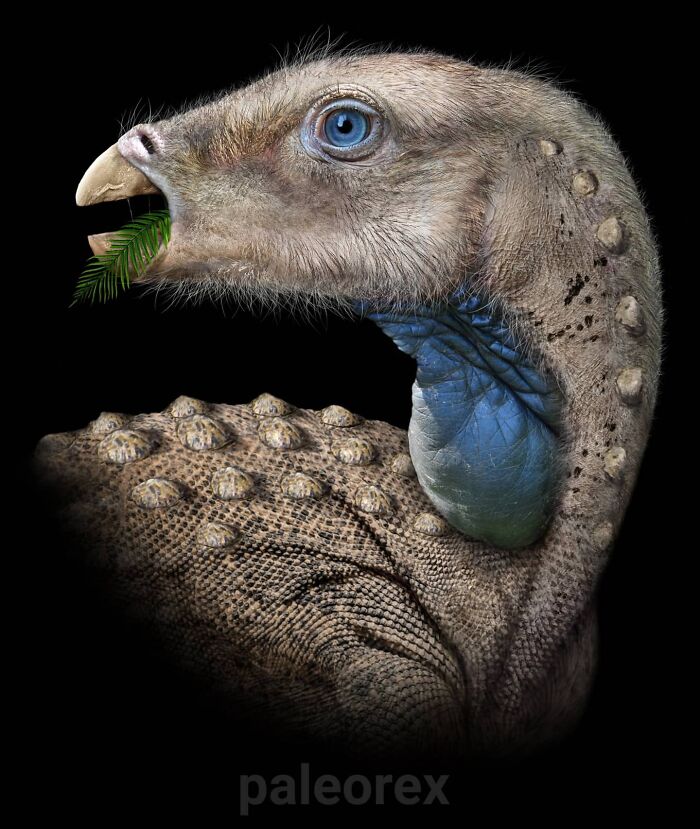 Image credits: paleorex
Image credits: paleorex
#29 Hamipterus
Hamipterus was an early Cretaceous pterosaur that once lived in northwestern China. Its skull was relatively long and narrow, and on the top it had a long, bony crest running from near the tip of the snout to the rear of the skull. The teeth were thin, widely spaced and conical, and the tooth row extended for almost the entire length of the upper and lower jaws. It also estimated that Hamipterus would have grown to have a wingspan of up to 3.5 m, making it a medium-sized pterosaur.
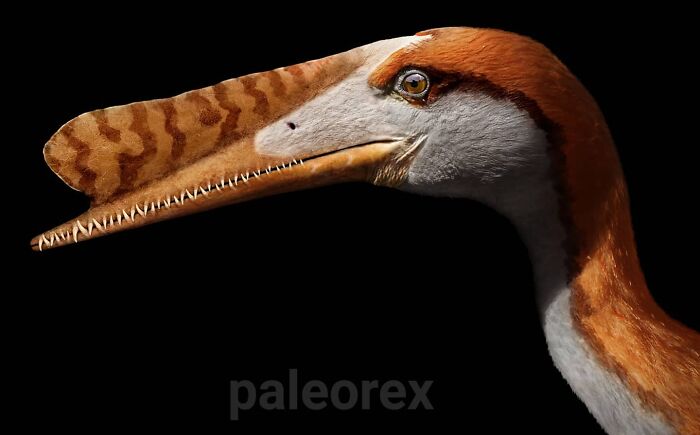 Image credits: paleorex
Image credits: paleorex
#30 Utahraptor
Utahraptor, meaning Utah’s predator, was one of the largest dromaeosaurid theropod dinosaurs or raptors to ever exist. It lived in North America during the Early Cretaceous period. Unlike most dromaeosaurids, it was much more heavy-built, comparable to a polar bear in weight, and estimated to have reached up to 7 meters in length. Like most of its kind, it possessed a large sickle claw, perfectly adapted to dispatch its prey. Although feathers have never been found in association with Utahraptor specimens, there is strong phylogenetic evidence suggesting that all dromaeosaurids possessed them.
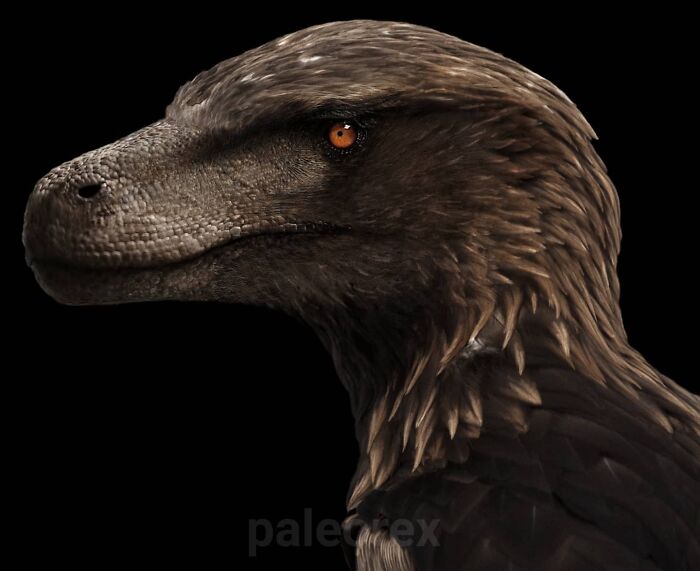 Image credits: paleorex
Image credits: paleorex
#31 Proceratosaurus
Proceratosaurus had unusually large nostrils and a crest on its head. It lived in what is now England, about 167 million years ago, during the Middle Jurassic. Like most of the others theropods, Proceratosaurus was a predator and had sharp serrated teeth. Although it is known only from the discovery of a single partial skull, a recent examination of the same revealed many similarities with the Asian tyrannosauroids. Indeed, the shape of the teeth and the cranial crest of Proceratosaurus are characteristics also shared by the Guanlong (a primitive ancestor of Tyrannosaurus rex). Thus, based on these recent observations, it can be assumed that the Proceratosaurus is one of the oldest tyrannosaurids ever discovered.
 Image credits: paleorex
Image credits: paleorex
#32 Europejara
Europejara is a relatively small pterosaur with an estimated wingspan of 2 metres. The jaws were toothless and the lower jaws bear a large downwards pointing crest. The diet of Europejara is still matter of debate. It lived during the early Cretaceous period, in what is now Spain, when most of Europe was made up of islands, surrounded by wide shallow seas. It is therefore likely that Europejara ate fish. However it is also possible that this pterosaur ate fruit, using its peculiar beak to better separate the fruit flesh from the seeds, like some extant toucans.
 Image credits: paleorex
Image credits: paleorex
#33 Albertosaurus
Albertosaurus was a close relative of Tyrannosaurus, but smaller and not as heavily built. In lived in western North America during the Late Cretaceous Period, about 70 million years ago. Albertosaurus was a fierce predator and, on average, adults measured up to 9 m long and weighed between 1.3 tonnes and 1.7 tonnes, making them the apex predators of their environment.
 Image credits: paleorex
Image credits: paleorex
#34 Majungasaurus
Known from several well-preserved skeletal remains found in Madagascar, Majungasaurus has become one of the best-studied theropod dinosaurs from the Southern Hemisphere. It appears to be most closely related to the abelisaurids, a unique and bizarre group of carnivorous therapod dinosaurs that lived during the late Cretaceous.
Majungasaurus shared common characteristics with other abelisaurids, mainly the short snout and very short forelimbs. However, it was distinct for its wider skull and a single rounded horn on the roof of its skull. It also had a very rough, sculptured texture and thickened bone on the outside faces of the skull bones. This was carried to an extreme on the nasal bones, which were extremely thick and fused together. In life, these structures would have been covered with some sort of integument, possibly made of keratin. Majungasaurus was a medium-sized theropod that measured on average around 7 meters in length, though being the largest and most fierce predator in its domain.
 Image credits: paleorex
Image credits: paleorex

#53 Scipionyx
Scipionyx was a theropod dinosaur from the Early Cretaceous of Italy. There is only one perfectly preserved fossil known of Scipionyx, discovered in 1981 by an amateur paleontologist and brought to the attention of the scientific community in 1993. The fossil is that of a juvenile, the length being just 237 millimetres, and experts believe that it was perhaps just three days old. The full adult size of this carnivorous dinosaur is therefore still unknown.
 Image credits: paleorex
Image credits: paleorex
#54 Monolophosaurus
Monolophosaurus was a medium size theropod dinosaur from the Middle Jurassic period. It was named after the large and single crest on top of its skull, which was probably brightly colored to aid in mating rituals. The only specimen that has been discovered measured 5 metres in length and weighed about 500 kilograms.
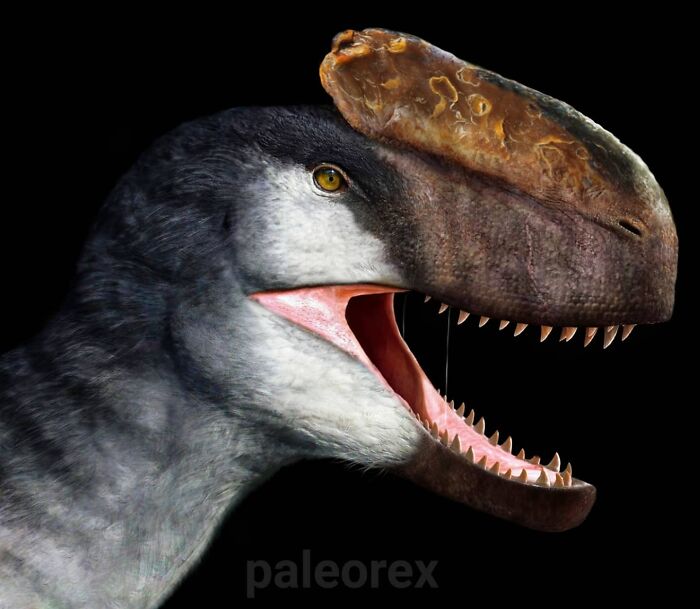 Image credits: paleorex
Image credits: paleorex
#55 Aardonyx
Aardonyx was a basal sauropodomorph dinosaur that lived during the Early Jurassic in South Africa. It was about 7 meters long, 2 meters tall at the hips, and weighed around 500 kilograms.
Experts believe that Aardonyx represents the transitional stage between bipedal ancestors and quadrupedal sauropod descendants, and this is evident when considering its strong legs, which show adaptations for slow and forceful walking, like larger long necked dinosaurs.
 Image credits: paleorex
Image credits: paleorex
#56 Camptosaurus
Camptosaurus is a genus of plant-eating, beaked ornithischian dinosaurs that lived in the Late Jurassic in western North America. Adult Camptosaurus could have reached up to 7 meters in length and about 830 kg in weight. And, based on studies of other iguanodonts, experts believe this dinosaur may have been able to achieve running speeds of up to 25 km per hour, to avoid the large and hungry Jurassic predators like Allosaurus.
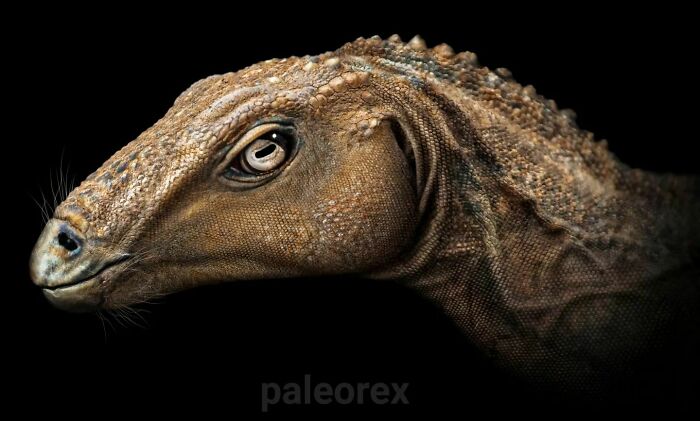 Image credits: paleorex
Image credits: paleorex
#57 Tarbosaurus
Tarbosaurus is a genus of tyrannosaurid dinosaurs that roamed in Asia about 70 million years ago, at the end of the Late Cretaceous Period. Fossils have been recovered in Mongolia, with more fragmentary remains found further afield in parts of China.
Tarbosaurus was nearly as large as the fearsome Tyrannosaurus rex. While T-Rex can be called the Late Cretaceous king of the North American, Tarbosaurus was its counterpart in Asia. It had the smallest arms of any large tyrannosaur relative to its body size.
 Image credits: paleorex
Image credits: paleorex
#58 Megapnosaurus
Megapnosaurus, also known as Syntarsus (possibly synonymous with Coelophysis), was a primitive theropod dinosaur.
By the standards of the early Jurassic period, about 190 million years ago, this meat-eating dinosaur was relatively large in size: it measured 3 meters in length and may have weighed about 30 kilograms. It was an agile predator, much like Coelophysis. The bones of 30 Megapnosaurus individuals were found all together in a fossil bed in Zimbabwe, so paleontologists believe that this early theropod may have hunted in packs.
 Image credits: paleorex
Image credits: paleorex
#59 Torvosaurus
Torvosaurus, meaning “savage lizard” in Greek, was a large megalosaurid theropod from the Late Jurassic Morrison Formations, which lived about 145 million years ago.
It was one of the largest known Jurassic theropods, rivaling other large predators, such as Saurophaganax, Allosaurus and Megalosaurus in size. It is estimated that it grew between 9 to 11 meters in length, and weighed between 2.5 and 5 tons, making it one of the largest carnivores to inhabit the Earth until the Late Jurassic. And, given its size, it was likely the top predator in what is now Portugal.
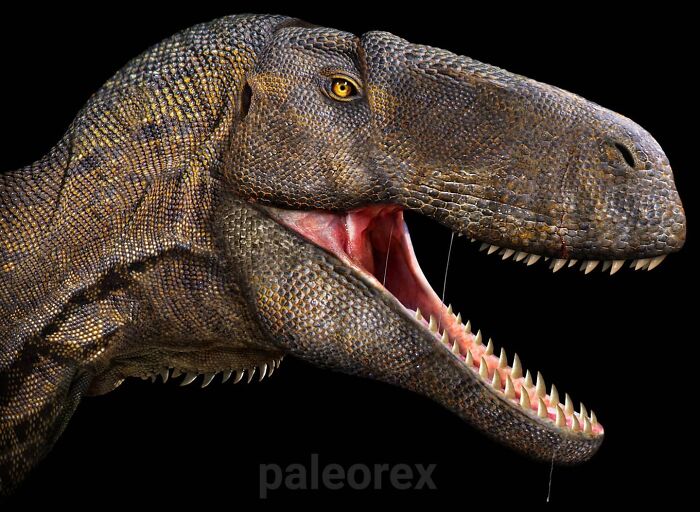 Image credits: paleorex
Image credits: paleorex
#60 Qianzhousaurus
Qianzhousaurus is often referred to by the nickname “Pinocchio Rex” for its long snout in comparison with other known tyrannosaurs. It was discovered in southern China and lived around 70 million years ago. Aside from its signature snout, Qianzhousaurus also had long and narrow teeth, while its relatives, like Tyrannosaurus rex and Tarbosaurus, had thick teeth and powerful, deep-set jaws for crushing their prey. Although only the skull of this animal has been discovered, it is estimated that Qianzhousaurus was 6.3 long and weighed about 750 kg.
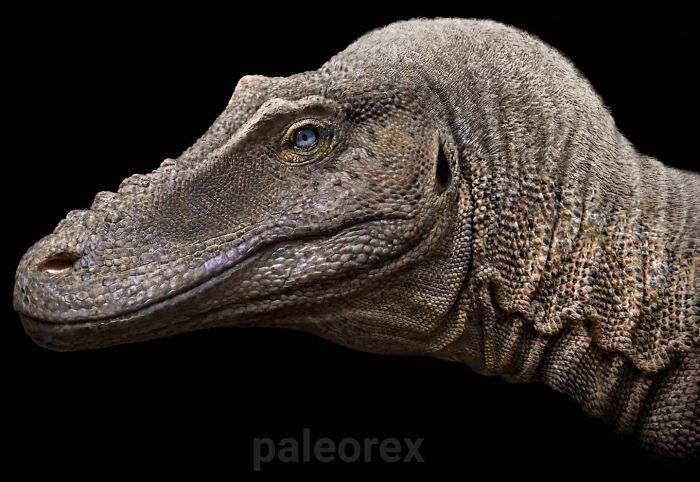 Image credits: paleorex
Image credits: paleorex
#61 Eocursor
Eocursor is a genus of basal ornithischian dinosaur that lived in what is now South Africa during the Early Jurassic.
It was a relatively small, lightly built and gentle herbivore that measured about 1 meter in length.
 Image credits: paleorex
Image credits: paleorex
#62 Pisanosaurus
Pisanosaurus was a small, lightly-built herbivore that lived approximately 220 million years ago during the Late Triassic Period in what is now South America. It could grow up to 1 meter in length and weigh between 2.5 and 9 kilograms.
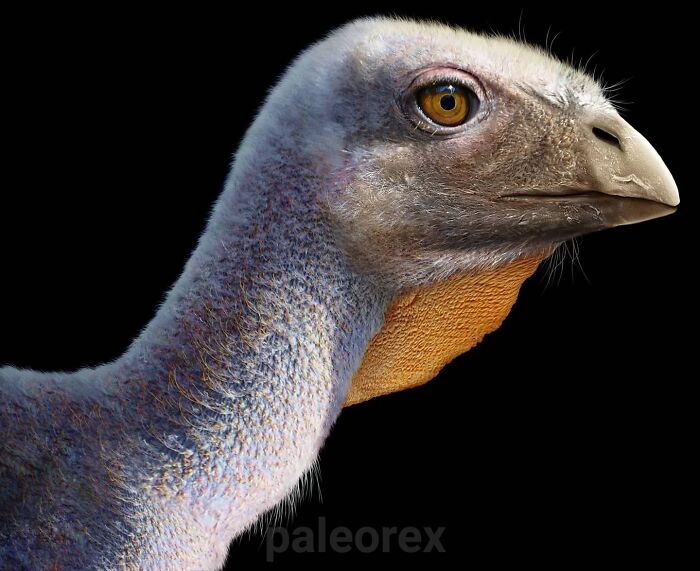 Image credits: paleorex
Image credits: paleorex
#63 Eoraptor
Eoraptor was a small, lightly-built, basal saurischian dinosaur. It is recognized as one of the earliest-known dinosaurs and lived about 230 million years ago during the Late Triassic in Western Gondwana, in the region that is now known as northwestern Argentina.
 Image credits: paleorex
Image credits: paleorex
#64 Camptosaurus
Camptosaurus is a genus of plant-eating, beaked ornithischian dinosaurs that lived in the Late Jurassic in western North America. Adult Camptosaurus could have reached up to 7 meters in length and about 830 kg in weight. And, based on studies of other iguanodonts, experts believe they may have been able to achieve running speeds of up to 25 km per hour, to avoid the large and hungry Jurassic predators like Allosaurus.
 Image credits: paleorex
Image credits: paleorex
#65 Iguanodon
Iguanodon was the largest, best known, and most widespread of all the iguanodontids, a group of herbivorous dinosaurs that is closely related to the hadrosaurs, or duck-billed dinosaurs. Iguanodon lived during the Jurassic and Cretaceous and was up to 9 metres long, stood nearly 2 metres tall at the hip, and weighed approximately 5 tons.
 Image credits: paleorex
Image credits: paleorex
#66 Herrerasaurus
Herrerasaurus lived about 237 million years ago, during the late Triassic, in Argentina. It was a contemporary of Eoraptor but much larger and more advanced. Its build was slender but strong, the hind limbs long and powerful and the front limbs very muscular. In addition, it had large claws on its hands that were used to grab prey, and sharp teeth to tear through flesh. Like many of the primitive dinosaurs, it was a carnivorous and bipedal animal. One reason for the success of the early dinosaurs was their ability to move quickly and nimbly on two legs.
 Image credits: paleorex
Image credits: paleorex
#67 Supersaurus
Supersaurus was one of the largest sauropod dinosaurs to ever exist. Its fossil remains have been found in North America and date to about 153 million years ago. It possibly reached 34 meters in length, and a weight of 36 metric tons. It also had an incredibly long neck that was perfectly adapted to reach the tall Jurassic tree canopies and vegetation which it fed on.
 Image credits: paleorex
Image credits: paleorex
#68 Saurornitholestes
Saurornitholestes is a genus of carnivorous dromaeosaurid theropod dinosaur that lived in the late Cretaceous in Canada.
Compared to other members in the Dromaeosauridae family, Saurornitholestes was more long-legged and lightly built. It resembled the well-known Velociraptor; it had large, fanglike teeth in the front of the jaws, a long, curving, blade-like claw on the second toe and measured almost the same length (1.8 m).
 Image credits: paleorex
Image credits: paleorex
#69 Liliensternus
Liliensternus was a basal neotheropod dinosaur that lived about 210 million years ago during the Late Triassic in what is now Germany.It is considered to be an intermediate between Coelophysis and Dilophosaurus, hence, it is often depicted with a small crest on the top of its skull to resemble that of a Dilophosaurus.Liliensternus was a moderate-sized, bipedal carnivore, that could grow up to 5 meters in length.Unfortunately, no Liliensternus specimen has been preserved with skin impressions, so it is unknown whether Liliensternus (and its relatives) had feathers or proto-feathers. In case it had, these structures would have allowed Liliensternus to maintain its body temperature.
 Image credits: paleorex
Image credits: paleorex
#70 Tarbosaurus
Tarbosaurus is a genus of tyrannosaurid dinosaur that flourished in Asia about 70 million years ago, at the end of the Late Cretaceous Period. Fossils have been recovered in Mongolia, with more fragmentary remains found further afield in parts of China.
Tarbosaurus was nearly as large as the fearsome Tyrannosaurus rex. While T-Rex can be called the Late Cretaceous king of the North American, Tarbosaurus was its counterpart in Asia. It had the smallest arms of any large tyrannosaur relative to its body size.
 Image credits: paleorex
Image credits: paleorex
Recommended Videos
 Two Buddhist Temples in the Air412 views
Two Buddhist Temples in the Air412 views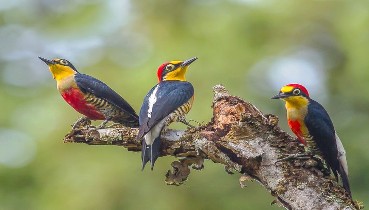 Yellow-fronted Woodpeckers (Melanerpes flavifrons)1996 views
Yellow-fronted Woodpeckers (Melanerpes flavifrons)1996 views-
Advertisements
 The Sheerest, Most Straight-Up 'Naked' Dresses to Ever Hit the Red Carpet1134 views
The Sheerest, Most Straight-Up 'Naked' Dresses to Ever Hit the Red Carpet1134 views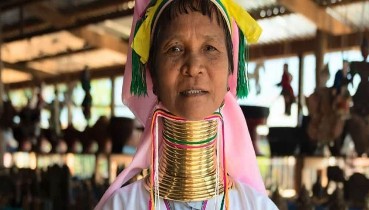 10 Bizarre Beauty Standards From Around The World545 views
10 Bizarre Beauty Standards From Around The World545 views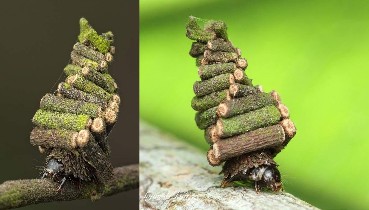 Bagworm Moths Build Tiny Portable Houses for Themselves That Are Almost Impenetrable31134 views
Bagworm Moths Build Tiny Portable Houses for Themselves That Are Almost Impenetrable31134 views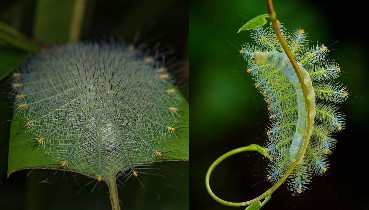 Caterpillar of Archduke butterfly (Lexias pardalis dirteana)10390 views
Caterpillar of Archduke butterfly (Lexias pardalis dirteana)10390 views The western rosella (Platycercus icterotis), or moyadong, is a species of parrot endemic to southern Western Australia.2998 views
The western rosella (Platycercus icterotis), or moyadong, is a species of parrot endemic to southern Western Australia.2998 views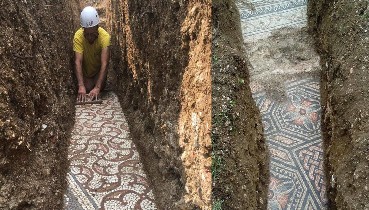 Archaeologists Find Ancient Roman Mosaic Under Vineyard In Italy And It’s In Great Condition236 views
Archaeologists Find Ancient Roman Mosaic Under Vineyard In Italy And It’s In Great Condition236 views

